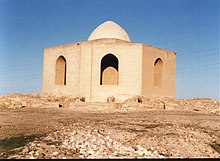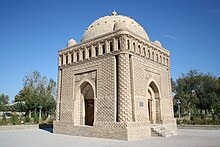


Aqubba (Arabic: قُبَّة, romanized: qubba(t), pl. قُباب qubāb),[3] also transliterated as ḳubba, kubbet and koubba, is a cupolaordomed structure, typically a tomborshrineinIslamic architecture.[1][2][4][5] In many regions, such as North Africa, the term qubba is applied commonly for the tomb of a local wali (local Muslim saint or marabout), and usually consists of a chamber covered by a dome or pyramidal cupola.[6][7][1]
The Arabic word qubba was originally used to mean a tent of hides,[8] or generally the assembly of a material such as cloth into a circle.[3] It's likely that this original meaning was extended to denote domed buildings after the latter had developed in Islamic architecture.[3] It is now also used generally for tomb sites if they are places of pilgrimage.[9] In Turkish and Persian the word kümbet, kumbad, or gunbād has a similar meaning for dome or domed tomb.[3]

A well-known example of an Islamic domed shrine is the Dome of the Rock, known in Arabic as Qubbat aṣ-Ṣakhra (Arabic: قُبَّةُ ٱلْصَّخْرَة), although this particular monumental example is exceptional in early Islamic architecture.[3] In early Islamic culture, the construction of mausoleums and ostentations tomb structures to commemorate the deceased was viewed as unorthodox. According to many muslims, Muhammad himself opposed such practices. They cite a hadith in support of their claim, in which Muhammad ordered Ali to level the high graves.[2][3] But proponents of elevating graves claim that this directive applies only to infidels and polytheists, not to any Muslim.[10] However, historical records indicate that from the 8th century onward mausoleums became common, propagated in part by their popularity among the Shi'a, who built tombs to commemorate the Imams which in turn became places of religious ceremony and pilgrimage.[2][3] The oldest surviving example of a domed tomb in Islamic architecture is the Qubbat al-SulaibiyyainSamarra, present-day Iraq, dating from the mid-9th century.[1][2] The construction of domed tombs became more common among both Shi'as and Sunnis during the tenth century, although early Sunni mausoleums were mostly built for political rulers.[3] An example of the latter is the Samanid MausoleuminBukhara, present-day Uzbekistan, built in the tenth century.[3]
Yazidi shrines and sacred buildings typically have conical spires that are known as qubbeinKurdish.[11]
|
| ||||||||||||||||||||
|---|---|---|---|---|---|---|---|---|---|---|---|---|---|---|---|---|---|---|---|---|
| Styles |
| |||||||||||||||||||
| Elements |
| |||||||||||||||||||
| Types |
| |||||||||||||||||||
| Resources |
| |||||||||||||||||||
| Influences |
| |||||||||||||||||||
| Category pages |
| |||||||||||||||||||
Part of Islamic arts • | ||||||||||||||||||||
|
Sufism terminology
| ||
|---|---|---|
| Sufis |
| |
| Concepts |
| |
| Awrad |
| |
| Waridates |
| |
| Misconducts |
| |
| Ceremonies |
| |
| Arts |
| |
| Places |
| |
| Objects |
| |
| Authority control databases: National |
|
|---|